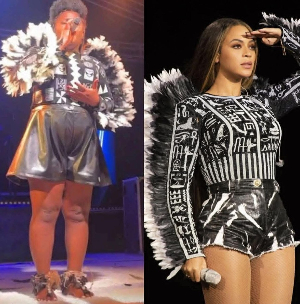The idea to buy a new presidential jet was first floated in 1989 after the existing Boeing 727 which Biya inherited from Ahmadou Ahidjo developed serious technical problems and was crash-landed in the Douala swamps on its way back from an OAU summit in Abuja, Nigeria.Biya and the official Cameroon delegation were so scared that the President swore never to enter the plain again.
The assignment to get a new plane was given to the then General Manager of Cameroon Airlines (Camair), Cyrille Etoundi Atangana; who opened negotiations with an American firm Ansett Worldwide that had leasing agreements with Camair.
But the initiative remained still-born because the government was broke. Fast-track to 2001; Camair management was seeking short term international financing to expand its float with two new planes (Boeing 767-200; “Le Dja” and Boeing 747-300; “Big Boss”)following an incident in which a plane transporting Biya from an Asian visit was refused transit landing in Europe to refuel until Yves-Michel Fotso; then General Manager of Commercial Bank of Cameroon (CBC) and a member of the delegation agreed to pay the outstanding fuel and landing charges on the hired plane using his personal credit card.Biya’s ever frequent trips abroad had become a source of considerable embarrassment and it was time a plane be bought for the President.
In the Beginning, there was GIA International As Camair sought financing for the two new planes it wanted to acquire, Yves-Michel Fotsoclaimed that he was contacted by Jean-Marie Assene Nkou, Group Managing Director (PDG) of National Airways Cameroon (NACAM), who suggested Camair negotiates with an American outfit, GIA International, which Assene Nkou said had financed the two 19-seater Beechcraft 1900 which NACAM was operating in Cameroon.
To which end, a delegation comprising Yves-Michel Fotso, Michel Villoingt, financial adviser to Camair on secondment from Air France and Assene Nkou as Commissioning Negotiator met GIA representatives,Fernando Gomez Mazuera and Kosta Diamantakos in Johannesburg, South Africa on July 12, 2001.
Three days later, Michel Villoingt recommended that the government of Cameroon issues a standby letter of credit as guarantee for Camair to get the planes on lease-to-own bases. And so was born the unholy alliance between Camair and GIA International.
According to documents filed with the US Securities and Exchange Commission (SEC), GIA International was incorporated as a business entity in the state of Delaware on February 27, 1996.
The company’s articles of association registered by notary, Cheryl A. Lewis and its authorization license signed by the then Delaware Secretary of State, Edward J. Freel, listed as its principal officers; Russell Lorenzo Meek, President and CEO; Fernando Aurelio Gomez Mazuera, Financial Director and Haï Cunningham, Director and Secretary to the Board of Administrators.
The company held its first Board meeting on July 10, 1996 and in another Board meeting resolution of July 23, 1999, the Board indicated that only the three officers are mandated to manage the company’s accounts operated with Bank of America.
Nowhere is any Cameroonian shareholder mentioned either in the GIA rooster or in its minutes or resolutions that Assene Nkou was their designated representative for Central Africa. This fact is worth emphasizing because until he was arrested as he tried to escape to Equatorial Guinea, Assene Nkou claimed he was the GIA International representative in Central Africa. It is also important in the light of the involvements by Yves-Michel Fotso in the management and operation of GIA accounts.
When in 2001, President Paul Biya decided to purchase a new presidential aircraft; he directed the then Secretary General at the Presidency, Marafa Hamidou Yaya to handle the issue.
Cameroon was neck-deep in the IMF- World Bank Structural Adjustment Program (SAP), and these institutions had rigorous oversight over government expenditures and would have vetoed any luxury expenses.
To avoid the scrutiny of the donor institutions, the Biya and his gang decided to mask the Boeing Business Jet (BBJ-2) as a new acquisition of the then state-owned Cameroon Airlines, where Yves-Michel Fotso had been appointed General Manager (ADG), ostensibly for bailing out the President.
Upon his return from Johannesburg, Yves-Michel Fotso reported his meeting and the proposed deal with GIA to the Presidency, which now saw in the deal, an opportunity to buy a plane for the president that had been in the works since the botched negotiations with Ansett Worldwide in 1999. Fotso was then was summoned in mid-August to a meeting at the Presidency by Marafa.
At the meeting that was also attended by then Economy and Finance Minister, Michel Meva’a Meboutou and the former deceased Chief of Staff of the Presidential Security,General Blaise Bénaé Mpecke, Yves-Michel was told of the plot to buy a plane for the President that would pass off as a Camair acquisition to avoid IMF-World Bank scrutiny.
Fotso recounted the deal he had struck with GIA International and asked the government to issue the standby letter of credit but that option was out rightly rejected by Meva’a who feared it might expose the government’s implication in the deal and jeopardize efforts by Cameroon to reach the much-awaited completion point of the Highly Indebted Poor Countries Initiative (HIPC).
...The search for the truth continues
Opinions of Monday, 8 December 2014
Auteur: Cameroon Concord















